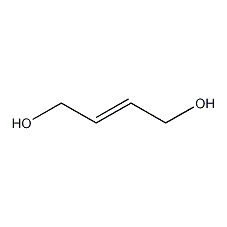2-Butene-1,4-diol 2-Butene-1,4-diol

Structural formula
| Business number | 031P |
|---|---|
| Molecular formula | C4H8O2 |
| Molecular weight | 88 |
| label |
1,4-dihydroxy-dibutene, cis-2-butene-1,4-diol, 1,4-Butenediol, 1,4-dihydroxy-2-butene, cis-1,4-Dihydroxy-2-butene, Aliphatic alcohols, ethers and their derivatives |
Numbering system
CAS number:110-64-5
MDL number:MFCD00063207
EINECS number:228-085-1
RTECS number:EM4970000
BRN number:None
PubChem ID:None
Physical property data
1. Properties: Colorless, viscous liquid, odorless. There are two types: cis and trans. Industrial products are often mixtures, and contain more cis components.
2. Boiling point (ºC, 101.3kPa): 235 (cis)
3. Boiling point (ºC, 101.3kPa): 235~238 (trans)
4. Melting point (ºC): 11.77 (cis)
5. Melting point (ºC): 22.5 (trans)
6. Relative density (g/mL, 20/4ºC): 1.080 (cis)
7. Relative density (g/mL, 20/4ºC): 1.070 (trans)
8. Relative vapor density (g /mL, air=1): Undetermined
9. Refractive index (25ºC): 1.4716 (cis)
10. Refractive index (20ºC): 1.4755 (trans)
11. Viscosity (mPa·s, 20ºC): 21.8 (cis)
12. Viscosity (mPa·s, 60ºC): 5.9 (cis)
13. Flash point (ºC): 128 (cis)
14. Heat of combustion (KJ/mol): 2328.7 (cis)
15. Specific heat capacity (KJ /(kg·K), 20ºC, constant pressure): 2.25 (cis)
16. Solubility: miscible with water, alcohol, acetone, ester, ether, etc., to benzene, halogenated Hydrocarbons are insoluble.
Toxicological data
1. Acute toxicity: Rat abdomen LD50: 327mg/kg
Mouse varicose veins LD50:> 316mg/kg
Rat LD50: 1250mg/kg
Ecological data
None yet
Molecular structure data
1. Molar refractive index: 23.70
2. Molar �Volume (cm3/mol): 83.1
3. Isotonic specific volume (90.2K): 211.9
4. Surface tension (dyne/cm ): 42.1
5. Polarizability (10-24cm3): 9.39
Compute chemical data
1. Hydrophobic parameter calculation reference value (XlogP): -0.8
2. Number of hydrogen bond donors: 2
3. Number of hydrogen bond acceptors: 2
p>
4. Number of rotatable chemical bonds: 2
5. Number of tautomers:
6. Topological molecular polar surface area (TPSA): 40.5
p>
7. Number of heavy atoms: 6
8. Surface charge: 0
9. Complexity: 34.8
10. Number of isotope atoms : 0
11. Determine the number of atomic stereocenters: 0
12. Uncertain number of atomic stereocenters: 0
13. Determine the chemical bond configuration Number of centers: 1
14. Number of uncertain chemical bond stereocenters: 0
15. Number of covalent bond units: 1
Properties and stability
1. Flammable liquid, highly hygroscopic. A mixture of cis and trans isomers. It has the properties of general alkenes and primary alcohols. In the presence of acid, heating produces 2,5-dihydrofuran or crotonaldehyde, especially the cis isomer is prone to reaction. Heated to above 165°C, dehydration gradually occurs and polymerization occurs.
2.Non-corrosive and low toxicity. But it is irritating to skin and mucous membranes. The LD50 of white rabbit and guinea pig are 1.25ml/kg and 1.25~1.5ml/kg respectively. The production workshop should have good ventilation, and the equipment should be sealed to prevent leakage. Operators should wear protective equipment (such as goggles, gloves and masks, etc.).
Storage method
This product should be kept sealed. The product is packed in brown glass bottles and protected by wooden boxes.
Synthesis method
It is obtained by catalytic hydrogenation of butyne diol. Mix 40% butynediol aqueous solution and 50% Raney nickel, add the inhibitor ammonia water, and pass hydrogen at a pressure of about 0.5MPa until the theoretical hydrogen absorption capacity is reached. Filter, distill the filtrate under reduced pressure, and collect the 110-114°C (8kPa) fraction to obtain butenediol.
![]()
Refining method: contains water and a small amount Butynediol, butanediol, 3-butene-1,2-diol, 4-hydroxybutyraldehyde, 2,5-dihydrofuran and other impurities are generally refined by vacuum distillation. However, the cis-trans isomers are difficult to separate by distillation and can be refined by fractional crystallization.
Purpose
Mainly used for the preparation of pesticides; agricultural chemicals and vitamin B6 intermediates, a small amount is used in polymer production.